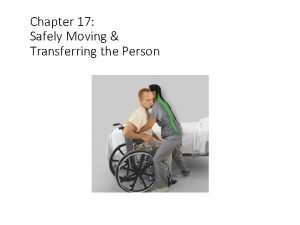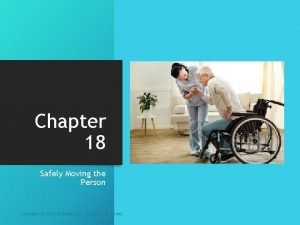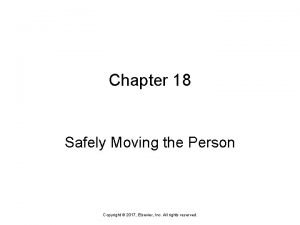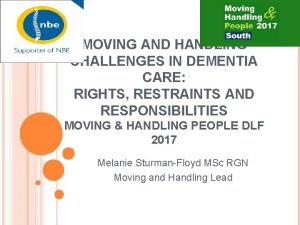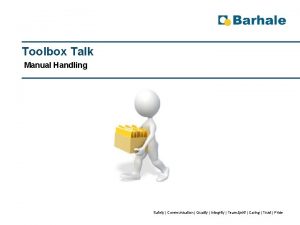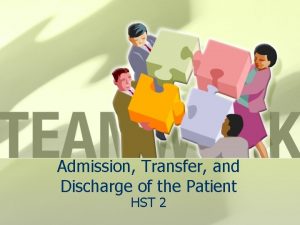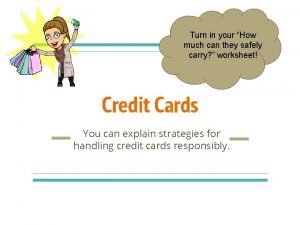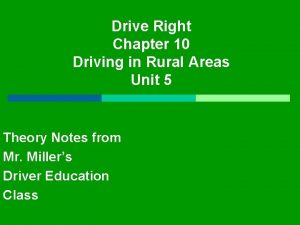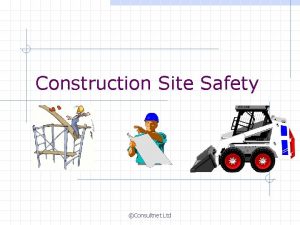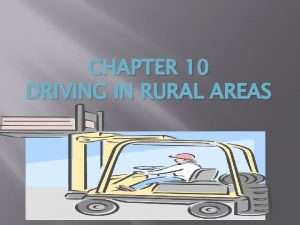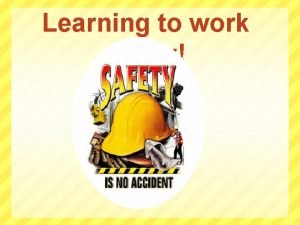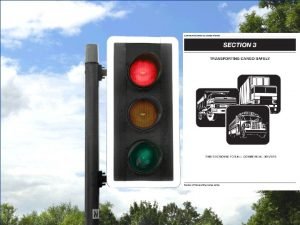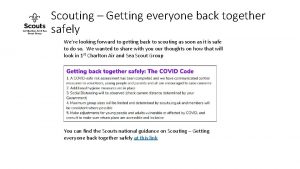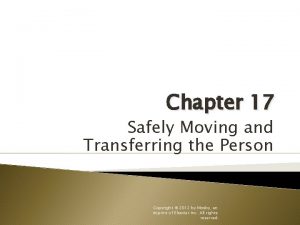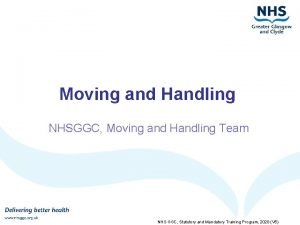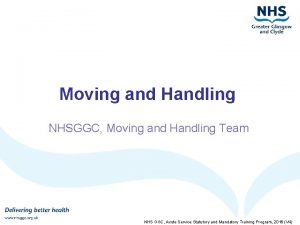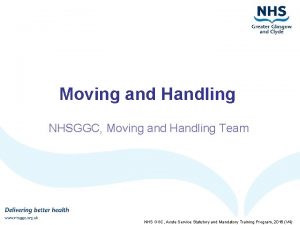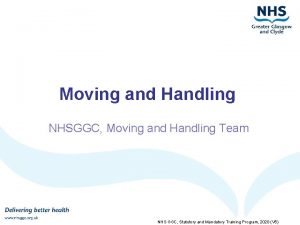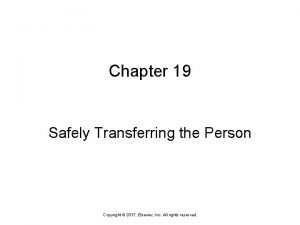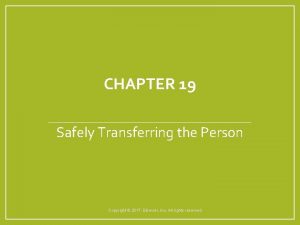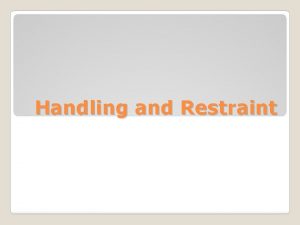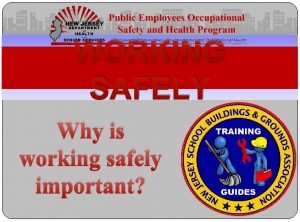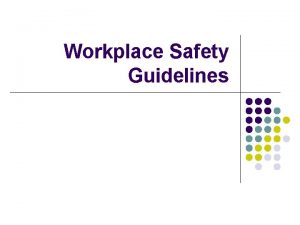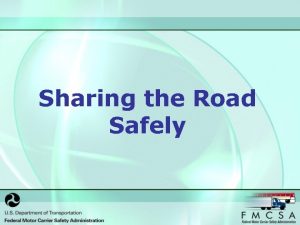Chapter 16 Safely Handling Moving and Transferring the






















- Slides: 22

Chapter 16 Safely Handling, Moving, and Transferring the Person Mosby items and derived items © 2008 by Mosby, Inc. , an affiliate of Elsevier Inc. Slide

Ø During these and other tasks, you must use your body correctly: • Turning and repositioning persons • Moving persons in bed • Transferring persons to and from beds, chairs, wheelchairs, stretchers, and toilets Mosby items and derived items © 2008 by Mosby, Inc. , an affiliate of Elsevier Inc. 2

PREVENTING WORK-RELATED INJURIES You must prevent work-related injuries when handling, moving, and transferring patients and residents. The Occupational Safety and Health Administration (OSHA) recommends that: Ø Ø • • Manual lifting be minimized in all cases Manual lifting be eliminated when possible Mosby items and derived items © 2008 by Mosby, Inc. , an affiliate of Elsevier Inc. 3

Ø To safely handle, move, and transfer the person, the nurse and health team determine: • The person’s dependence level • The amount of assistance needed • What procedure to use • The equipment needed Mosby items and derived items © 2008 by Mosby, Inc. , an affiliate of Elsevier Inc. 4

MOVING PERSONS IN BED Ø • OSHA recommends the following: For a dependence level of Code 4: Total Dependence • For a dependence level of Code 3: Extensive Assistance • • Use a mechanical lift or friction-reducing device. At least 2 staff members are needed. If the person weighs less than 200 pounds, 2 to 3 staff members and a friction-reducing device are needed. If the person weighs more than 200 pounds, at least 3 staff members and a friction-reducing device are needed. Mosby items and derived items © 2008 by Mosby, Inc. , an affiliate of Elsevier Inc. 5

Ø Protecting the skin • Protect the person’s skin during handling, moving, and transfer procedures. • Friction is the rubbing of one surface against another. Shearing is when the skin sticks to a surface while muscles slide in the direction the body is moving. Reduce friction and shearing when moving the person in bed by: Rolling the person Using friction-reducing devices Mosby items and derived items © 2008 by Mosby, Inc. , an affiliate of Elsevier Inc. 6

Ø Raising the person’s head and shoulders • You can raise the person’s head and shoulders easily and safely by locking arms with the person. • Do not pull on the person’s arm or shoulder. It is best to have help with older persons and with those who are heavy or hard to move. Mosby items and derived items © 2008 by Mosby, Inc. , an affiliate of Elsevier Inc. 7

Ø Moving the person up in bed • The person is moved up in bed for good alignment and comfort. • You can usually move small children up in bed alone. • You can sometimes move lightweight adults up in bed alone if they can assist and use a trapeze. It is best to have help and to use an assist device. • Two or more staff members are needed to move heavy, weak, and very old persons up in bed. • Always protect the person and yourself from injury. Mosby items and derived items © 2008 by Mosby, Inc. , an affiliate of Elsevier Inc. 8

Ø Moving the person up in bed with an assist device • The person is moved more evenly. • Shearing and friction are reduced. • At least two staff members are needed. • This procedure is used: For most patients and residents Following OSHA recommendations For persons recovering from spinal cord surgery or spinal cord injuries For older persons Mosby items and derived items © 2008 by Mosby, Inc. , an affiliate of Elsevier Inc. 9

Ø Moving the person to the side of the bed • The person is moved to the side of the bed: • • For repositioning and care procedures Before turning To limit the need to reach over the person One method involves moving the person in segments. Use a mechanical lift or the assist device method: Following OSHA recommendations For older persons For persons with arthritis For persons recovering from spinal cord injuries or spinal cord surgery Mosby items and derived items © 2008 by Mosby, Inc. , an affiliate of Elsevier Inc. 10

TURNING PERSONS Persons are turned onto their sides: Ø • • To help prevent complications from bedrest For certain procedures and care measures The person is turned toward you or away from you. Ø • The direction depends on the person’s condition and the situation. After the person is turned, position the person in good alignment. Ø • Use pillows for support as needed. Mosby items and derived items © 2008 by Mosby, Inc. , an affiliate of Elsevier Inc. 11

Ø Logrolling is turning the person as a unit, in alignment, with one motion. • The spine is kept straight. • The procedure is used to turn: Older persons with arthritic spines or knees Persons recovering from hip fractures Persons with spinal cord injuries Persons recovering from spinal surgery Mosby items and derived items © 2008 by Mosby, Inc. , an affiliate of Elsevier Inc. 12

SITTING ON THE SIDE OF THE BED (DANGLING) Patients and residents sit on the side of the bed (dangle) for many reasons. While dangling the legs, the person: Ø Ø • • Coughs and deep breathes Moves the legs back and forth in circles Two staff members may be needed. Ø • • Persons with balance and coordination problems need support. If dizziness or fainting occurs, lay the person down. Mosby items and derived items © 2008 by Mosby, Inc. , an affiliate of Elsevier Inc. 13

TRANSFERRING PERSONS The amount of help needed and the method used vary with the person’s dependency level. For a safe transfer: Ø Ø • • The room must be arranged so there is enough space. The chair, wheelchair, or other device must be placed correctly. Transfer belts/gait belts are used to: Ø • • Support patients and residents during transfers Reposition persons in chairs and wheelchairs Mosby items and derived items © 2008 by Mosby, Inc. , an affiliate of Elsevier Inc. 14

Ø Bed to chair or wheelchair transfers • Help the person out of bed on his or her strong side. • Stand pivot transfers are used if: Ø In transferring, the strong side moves first. The person’s legs are strong enough to bear some or all of his or her weight. The person is cooperative and can follow directions. The person can assist with the transfer. Chair or wheelchair to bed transfers have the same rules as bed to chair transfers. Mosby items and derived items © 2008 by Mosby, Inc. , an affiliate of Elsevier Inc. 15

Ø Mechanical lifts • Mechanical lifts are used to transfer persons who: • Cannot help themselves Are too heavy for the staff to transfer Slings The type of sling used depends on the person’s size, condition, and other needs. Follow agency policy and the manufacturer’s instructions for washing slings. Follow agency policy for handling and washing contaminated slings. Mosby items and derived items © 2008 by Mosby, Inc. , an affiliate of Elsevier Inc. 16

• Before using a mechanical lift: You must be trained in its use. It must work. The sling, straps, hooks, and chains must be in good repair. The person’s weight must not exceed the lift’s capacity. At least two staff members are needed. Always follow the manufacturer’s instructions. Mosby items and derived items © 2008 by Mosby, Inc. , an affiliate of Elsevier Inc. 17

Ø Transferring the person to and from the toilet • Transfers involving wheelchairs and toilets are often hard. • • Falls and work-related injuries are risks. Sometimes mechanical lifts are used. A slide board may be used if: The wheelchair armrests are removable. The person has upper body strength. The person has good sitting balance. There is enough room to position the wheelchair next to the toilet. Mosby items and derived items © 2008 by Mosby, Inc. , an affiliate of Elsevier Inc. 18

Ø Moving the person to a stretcher • Stretchers (gurneys) are used to transport persons who: • • • Cannot sit up Must stay in a lying position Are seriously ill The stretcher is covered with a folded flat sheet or bath blanket. A drawsheet, turning pad, large incontinence underpad, slide sheet, or slide board is used. At least 2 or 3 staff members are needed for a safe transfer. Mosby items and derived items © 2008 by Mosby, Inc. , an affiliate of Elsevier Inc. 19

• OSHA recommends the following: If the person weighs less than 100 pounds, use a lateral sliding aid and 2 staff members. If the person weighs 100 to 200 pounds, use a lateral sliding aid or a friction-reducing device and 2 staff members. If the person weighs more than 200 pounds, use one of the following: – – – A lateral sliding aid and 3 staff members A friction-reducing device or lateral transfer device and 2 staff members A mechanical lateral transfer device with a built-in slide board Mosby items and derived items © 2008 by Mosby, Inc. , an affiliate of Elsevier Inc. 20

• When the person is on the stretcher: Safety straps are used. The stretcher side rails are kept up during the transport. The stretcher is moved feet first. The staff member at the head of the stretcher can watch the person’s breathing and color. Never leave the person alone. Mosby items and derived items © 2008 by Mosby, Inc. , an affiliate of Elsevier Inc. 21

REPOSITIONING IN A CHAIR OR WHEELCHAIR For good alignment and safety, the person’s back and buttocks must be against the back of the chair. Follow the nurse’s directions and the care plan for the best way to reposition a person in a chair or wheelchair. Ø Ø • Do not pull the person from behind the chair or wheelchair. Mosby items and derived items © 2008 by Mosby, Inc. , an affiliate of Elsevier Inc. 22
 Chapter 19 safely transferring the person
Chapter 19 safely transferring the person Chapter 19 safely transferring the person
Chapter 19 safely transferring the person Chapter 18 safely moving the person
Chapter 18 safely moving the person Chapter 18 safely moving the person
Chapter 18 safely moving the person Lifting and transporting patients introduction
Lifting and transporting patients introduction Moving and handling dementia patients
Moving and handling dementia patients Moving and handling competency assessment template
Moving and handling competency assessment template Tool box talk on manual handling
Tool box talk on manual handling Chapter 11 admitting transferring and discharging
Chapter 11 admitting transferring and discharging Chapter 19 vocabulary glencoe health
Chapter 19 vocabulary glencoe health Understanding behaviour responding safely
Understanding behaviour responding safely How much can they safely carry
How much can they safely carry No job is so important that it cannot be performed safely
No job is so important that it cannot be performed safely Chapter 10 driving in rural areas
Chapter 10 driving in rural areas Chatting safely online
Chatting safely online No job is so important that it cannot be performed safely
No job is so important that it cannot be performed safely Chapter 10 driving in rural areas worksheet answers
Chapter 10 driving in rural areas worksheet answers What is macbeth's state of mind in act 3 scene 2
What is macbeth's state of mind in act 3 scene 2 Transporting food safely
Transporting food safely Work safely
Work safely The spot where you can no longer stop safely is
The spot where you can no longer stop safely is Name two basic reasons for covering cargo on an open bed
Name two basic reasons for covering cargo on an open bed Getting everyone back together safely
Getting everyone back together safely

